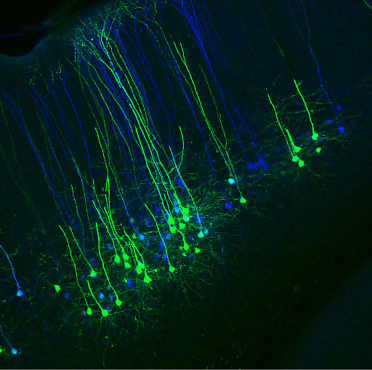[Seminar] "Motor circuits for locomotor and skilled movements.", Prof. Yutaka Yoshida.

Date
Location
Description
Speaker: Yutaka Yoshida
Associate Professor, Division of Developmental Biology, Cincinnati Children’s Hospital Medical Center
Title: Motor circuits for locomotor and skilled movements
Abstract: We have been interested in understanding the neural circuits underlying locomotor and skilled motor behaviors in mammals. The motor neuron activity integral to these neural circuits is regulated by synaptic inputs from three main pathways: local interneuron circuits, proprioceptive sensory feedback, and descending fibers from the brain, including the corticospinal (CS) tract.
We previously showed how proprioceptive sensory axons project to the spinal cord (Yoshida et al., 2006, Neuron; Leslie et al., 2011, Development), how they form specific connections with motor neuron targets (Pecho-Vrieseling et al., 2009, Nature; Fukuhara et al., 2013, Cell Reports), how maturation of synaptogenesis of sensory-motor circuits is regulated (Imai et al., 2016, J. Neuroscience), and how sensory-motor circuits are maintained into adulthood (Imai et al., 2016, Cell Repots). In this presentation, I will briefly talk about our published and unpublished studies on sensory-motor circuits.
In addition to proprioceptive sensory neurons, CS neurons control motor neuron activity for skilled movements such as reaching and grasping. Skilled movements have two unique features in mammals. First, the acquisition of skilled behaviors gradually occurs during postnatal development, requiring anatomical changes in neural circuitry to support the development of coordinated activation or suppression of functionally related muscle groups. We recently reported how the activity dependent, non-apoptotic Bax/Bak-caspase pathway regulates reorganization of CS motor circuits in mice (Gu et al., 2017, Neuron). Secondly, different species vary in their abilities to perform different skilled movements. For example, manual dexterity in higher primates is often superior to that of other animals. This trait emerged together with the appearance of cortico-motoneuronal (CM) connections during the evolution of the mammalian CS system, and was thought to be unique to higher primates. However, we identified CM connections in early postnatal mice, which are eventually eliminated by Sema6D-PlexA1 signaling. PlexA1 mutant mice maintain CM connections into adulthood, resulting in superior manual dexterity compared to controls. Furthermore, differing PlexA1 expression in layer 5 of the motor cortex, which is strong in wild-type mice but weak in humans, may be regulated by FEZF2-regulated cis-regulatory elements that are found only in higher primates. Thus, species-specific regulation of PlexA1 expression may be crucial to the evolution of enhanced fine motor control in higher primates.
In addition to the formation of motor circuits, we are also interested in the regeneration and reorganization of neural circuits following spinal cord injury (SCI). Immune suppression has been shown to be a leading cause of morbidity and mortality after SCI, however, the neuronal substrates responsible for post-injury immune suppression was, until now, unknown. We recently showed that profound plasticity develops within spinal autonomic circuitry innervating the spleen. Inhibition of spinal interneurons within the autonomic circuits blocked post-SCI immune suppression. This data provides new insights and potential therapeutic options for limiting the severe consequences of post-injury immune suppression (Ueno et al., 2016, Nature Neuroscience). Time permitting, I will briefly talk about this study at the end of my talk.
References)
1) Yoshida Y., Han B., Mendelsohn M., and Jessell T.M. (2006). PlexinA1 signaling directs the segregation of proprioceptive sensory axons in the developing spinal cord. Neuron 52, 775-88.
2) Leslie J.R., Imai F., Fukuhara K., Takegahara N., Rizvi T.A., Friedel R.H., Wang, F., Kumanogoh A., and Yoshida Y. (2011). Ectopic myelinating oligodendrocytes in the dorsal spinal cord as a consequence of altered semaphorin6D signaling inhibit synapse formation, Development, 138, 4085-95.
3) Pecho-Vrieseling E., Sigrist M., Yoshida Y., Jessell T.M., and Arber S. (2009). Specificity of Monosynaptic Sensory-Motor Connections Encoded by Sema3e-PlexinD1 Repulsion. Nature, 459, 842-6.
4) Fukuhara K., Imai F., Ladle D.R., Katayama K., Leslie J.R., Arber S., Jessell T.M., and Yoshida Y. (2013). Motor pool specificity of monosynaptic sensory connections imposed by repellent Sema3e-PlexD1 signaling. Cell Reports, 5, 748-58.
5) Imai F., Ladle D.R., Leslie J.R., Duan X., Rizvi T.A., Ciraolo G.M., Zheng Y., and Yoshida Y. (2016). Synapse formation in monosynaptic sensory-motor connections is regulated by presynaptic Rho GTPase Cdc42. Journal of Neuroscience, 36, 5724-5735.
6) Imai F., Chen X., Weirauch M.T., and Yoshida Y. (2016). Requirement of Dicer in maintenance of monosynaptic sensory-motor circuits in the spinal cord. Cell Reports, 17, 2163-72.
7) Gu G., Sarrad N., Ueno M., Liang M., Li J., Enquist L.W., Baccei M.R., Martin J.H., and Yoshida Y. (2017). Skilled movements require non-apoptotic Bax/Bak pathway-mediated corticospinal circuit reorganization. Neuron, 94, 626-641.
8) Ueno M., Ueno-Nakamura Y., Niehaus J., Popovich P.G., and Yoshida Y. (2016). Silencing spinal interneurons inhibits immune suppressive autonomic reflexes caused by spinal cord injury. Nature Neuroscience, 19, 784-787.
Subscribe to the OIST Calendar: Right-click to download, then open in your calendar application.



